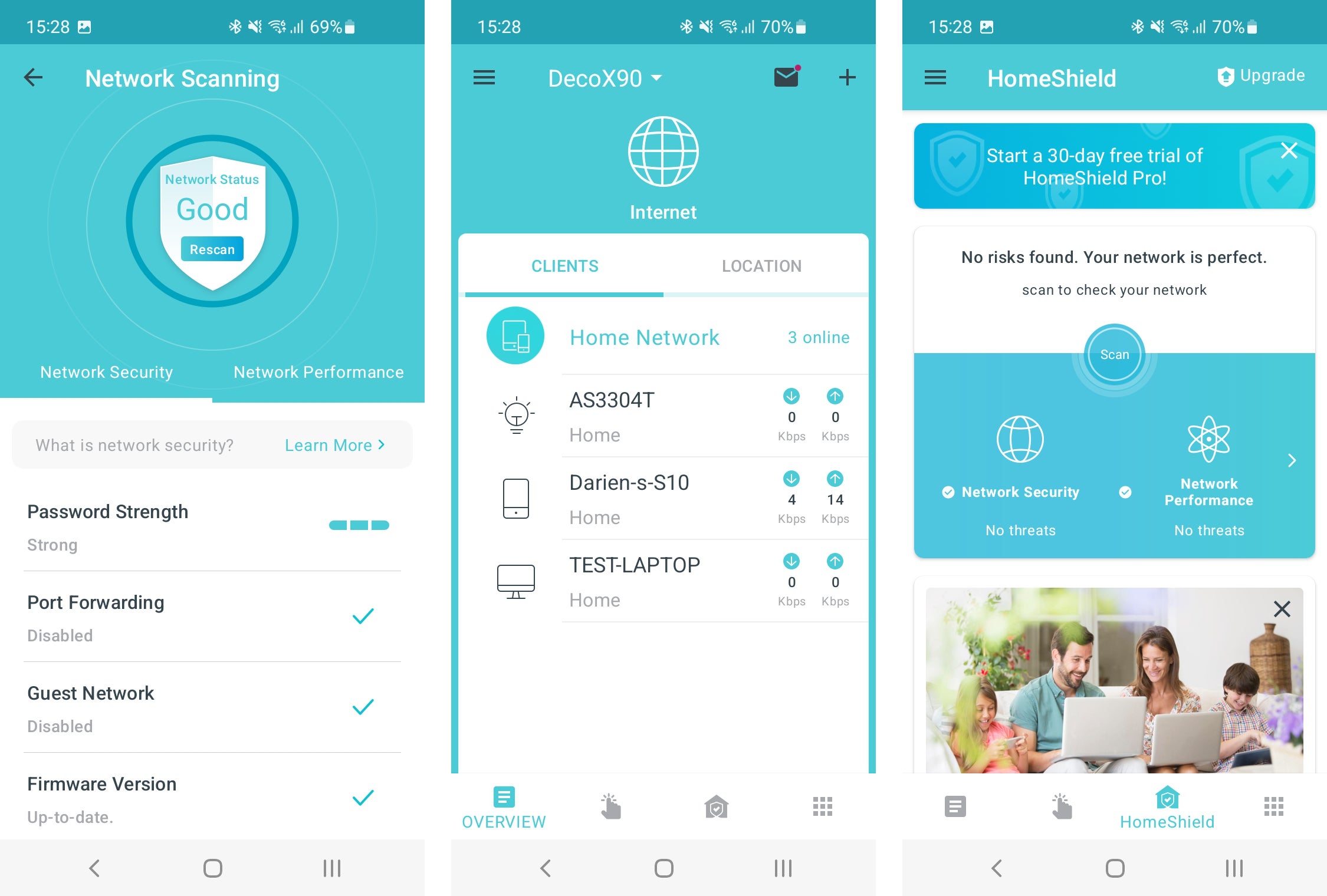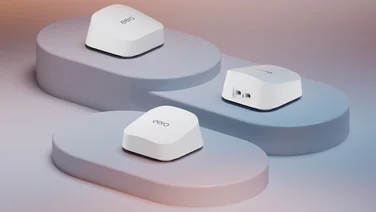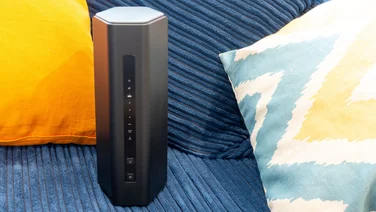To help us provide you with free impartial advice, we may earn a commission if you buy through links on our site. Learn more
- TP-Link Deco X90 mesh router review: What you need to know
- TP-Link Deco X90 mesh router review: Price and competition
- TP-Link Deco X90 mesh router review: Hardware design
- TP-Link Deco X90 mesh router review: Software features
- TP-Link Deco X90 mesh router review: Performance
- TP-Link Deco X90 mesh router review: Verdict

- Excellent headline speeds
- Strong signal throughout the whole home
- Basic security and parental controls
- Short on advanced features
- Only two network ports per unit
- Overkill for most households
TP-Link has released several mesh systems under the Deco brand, but the X90 is the most powerful we’ve seen. It’s designed for networks of up to 200 devices, in homes with as many as six bedrooms, and uses a tri-band radio configuration so the main wireless network doesn’t have to share bandwidth with the backhaul link.
The X90 also works with TP-Link’s HomeShield service. This provides network security and parental controls, and you can optionally upgrade to HomeShield Pro for extended features. Add in 2.5-Gigabit Ethernet and it’s an attractive proposition for anyone seeking to upgrade their home network to the latest standards – although 6GHz Wi-Fi 6E isn’t supported.
TP-Link Deco X90 mesh router review: What you need to know
The standard Deco X90 package contains two identical Deco units. One of these (it doesn’t matter which) replaces your current router, while the other sits a few rooms away and acts as an extender. You can also use the X90 system to extend an existing wireless network, although TP-Link’s HomeShield features aren’t available in this configuration.

Each Deco unit contains three wireless transceivers – a 2.4GHz radio with a top speed of 574Mbits/sec, a fast 5GHz client radio rated at 4.8Gbits/sec and a dedicated 5GHz backhaul transmitter that supports connections at up to 1.2Gbits/sec. It seems a weirdly unbalanced arrangement, but the Deco has the unusual ability to dynamically borrow bandwidth from the client radio to boost the backhaul connection as needed, giving it more flexibility than rival meshes.
As mentioned, TP-Link claims the system will support up to 200 clients, and 4×4 MU-MIMO support helps maximise throughput, whether there’s one or a dozen devices communicating at once. Both Wi-Fi 5 and Wi-Fi 6 are fully supported, although since there’s no 6GHz radio you won’t see any extra benefit for devices that work with the brand-new Wi-Fi 6E standard.
TP-Link Deco X90 mesh router review: Price and competition
The standard Deco X90 package costs £474; that may seem steep for only two units but together they provide an excellent breadth of coverage. For those who do need an extra station, additional X90 units can be bought for £245 each. If you’ve got that sort of money to spend then there are several alternative meshes to consider.
An obvious rival is the Netgear Orbi RBK752, another tri-band mesh with strong performance. It currently sells on Amazon at £370 for two nodes, or you can get a three-pack for £550.
Another option is the Linksys Atlas Pro 6. Although this lacks a dedicated backhaul radio, it’s rather cheaper than the TP-Link, at £362 for the three-node system, and we found it still did a good job of serving up a strong wireless signal throughout our whole home.
If top performance isn’t a priority then you could save a lot of money by going for the D-Link Eagle Pro M1 at £160 for three units, or the grey-market Xiaomi Mesh System AX3000, available via import at £55 per node.
Conversely, if you’re in the market for a premium solution, you might consider the Netgear Orbi RBK852, currently going for £650 for two stations. Check out our performance charts below before you invest, though, as the RBK852 is more than two years old, and no longer takes the crown for performance. The current king of domestic mesh systems is the blazingly fast Netgear Orbi RBKE953, which adds support for Wi-Fi 6E but the huge £1,500 price tag is hard to justify.
TP-Link Deco X90 mesh router review: Hardware design
The upright, tapered shape of the Deco X90 units makes them look a little like vases, though sadly you can’t enliven their plain white design by sticking tulips in them. They stand 210mm tall, with a maximum diameter of 130mm; you’d hardly call them low-key, but they’re inoffensive enough.
Each one has a power socket recessed into the underside, and a glowing LED near the base that changes colour to show the system status: yellow means booting up, flashing red means no internet or mesh connection, green means everything’s fine.
Aside from that, the only physical features are a pair of Ethernet sockets at the rear: one regular Gigabit port plus a 2.5GbE connector. The X90 is smart enough to work out which one is your internet connection, and you can optionally use the other for wired backhaul or for connecting a wired client. The flexibility and the multi-gig support are great to have, but there’s no USB connectivity and with just two ports per station you may need an external switch to connect all your devices.
READ NEXT: The best mesh Wi-Fi routers to buy
TP-Link Deco X90 mesh router review: Software features
The Deco smartphone app walks you quickly through setting up the X90 system, and thereafter takes care of network management. You can use it to browse connected devices, turn the main and guest networks on and off, configure address reservation and port forwarding, and assign per-device priority and parental control settings.
The app can also pop up notifications to alert you to new devices connecting and advise you of security scan results. Since remote access is enabled by default, you don’t need to be connected to the Deco network to stay on top of things.

The HomeShield page provides network security and parental controls. The basic features are included for free, including manual security scans, category-based website filtering and enforced bedtimes. Subscribing to HomeShield Pro for £54 a year unlocks router-based blocking of dangerous sites and content, with more flexible time-limiting within the parental control module and a whole lot of reports into what clients have been doing online – see the TP-Link website for the full list of HomeShield features.
Interestingly, the Deco app also integrates with a range of smart appliances, including Philips Hue, Samsung SmartThings and TP-Link’s own Kasa platform, so you can use the app to turn on lights, control smart switches and so forth, and even set up simple automations, such as turning your lights on whenever your smartphone connects to the Deco network.

It’s a decent spread of features, although you don’t get the VPN support that comes with Asus and Netgear devices – and, since there are no USB ports, there’s naturally no support for shared storage. If you prefer to use a traditional browser-based interface, note too that the Deco’s web dashboard only shows the network status, and doesn’t offer any controls or settings.
TP-Link Deco X90 mesh router review: Performance
TP-Link’s marketing for the Deco X90 trumpets its “AI-driven mesh technology”; this presumably means the adaptive backhaul capability, but since this operates behind the scenes it’s hard to say what it really does for you. I tested the system’s performance in my usual way, setting up the router unit in my study and the extender at the opposite end of the adjoining bedroom. The Deco chooses its own wireless settings and the app is oddly secretive about these; using a scanner app on my phone I determined that the Deco was broadcasting a 160MHz network centred on channel 42 in the 5GHz range.
I then connected an Asustor Drivestor Pro 4 NAS appliance to the primary Deco unit over 2.5GbE. Finally, I connected a test laptop, equipped with an Intel AX210 2×2 network card, to the 5GHz network and measured file upload and download speeds in various areas of my home. Here are the speeds I saw, along with those from various other mesh systems for comparison:


This is an outstanding performance. With my testing laptop in the same room as the router unit I saw download speeds of an incredible 147.6MB/sec over Wi-Fi 6. That’s the fastest connection we’ve seen from any mesh, even beating the Netgear Orbi RBKE963 running over a 6GHz Wi-Fi 6E link. There’s a stark generational gap between this and the older mesh solutions, which struggled to break through the 60MB/sec mark.
Perhaps more impressive is how effectively the Deco X90 projected coverage to all ends of my home. Clearly the highest speeds couldn’t be maintained once walls and other obstacles came into play: here Wi-Fi 6E showed its advantage, with the Orbi system proving consistently faster.
Even so, the Deco X90 delivered marvellously even download speeds no matter where I roamed, outpacing every other Wi-Fi 6 mesh in every location. No question about it, this system really does deliver on the promise of whole-home wireless.
READ NEXT: The best wireless routers to buy
TP-Link Deco X90 mesh router review: Verdict
£474 is a fair chunk of money, but we can’t grumble about what it gets you. The latest Wi-Fi 6 hardware unlocks speeds that were recently unthinkable at twice the price, and – perhaps thanks to its novel radio configuration – the Deco X90 does a superb job of distributing that bandwidth far and wide. Considering how close it comes to the performance of a new Wi-Fi 6E system, it’s arguably rather a bargain.
As always, it’s worth questioning whether you really need this sort of best-in-class wireless performance. If you’re regularly shunting gigabytes of data around your home network then perhaps you do, but the typical household won’t notice any benefit: even the dirt-cheap Xiaomi system has the bandwidth to stream multiple 4K HDR videos at once.
Then again, the Deco X90 has the headroom to serve a growing network for years to come – not just on the wireless front but with embedded 2.5GbE too. It doesn’t hurt that the free service covers basic security and parental controls, so you don’t feel strong-armed into yet another subscription.
It would have been nice to see a few additional Ethernet ports, and if you want USB or VPN support you’ll need to look elsewhere. For the core mesh services, however, you won’t find a better solution for anywhere near this price.






